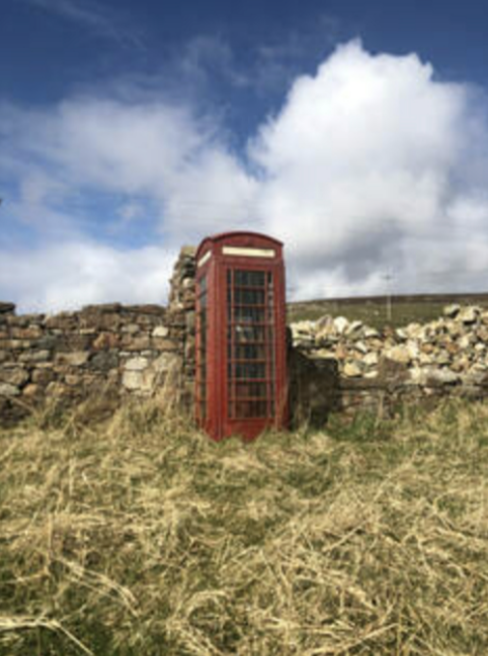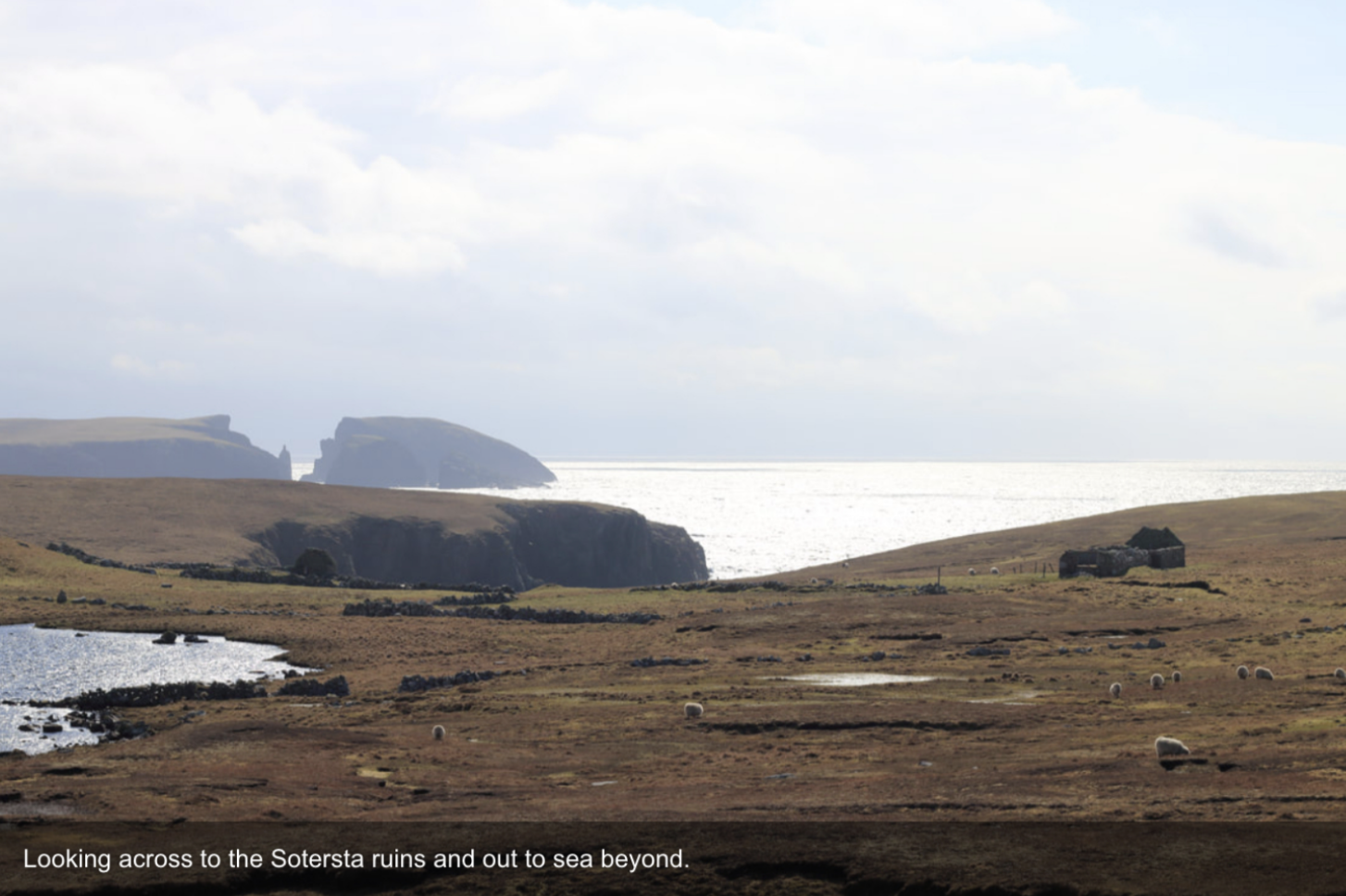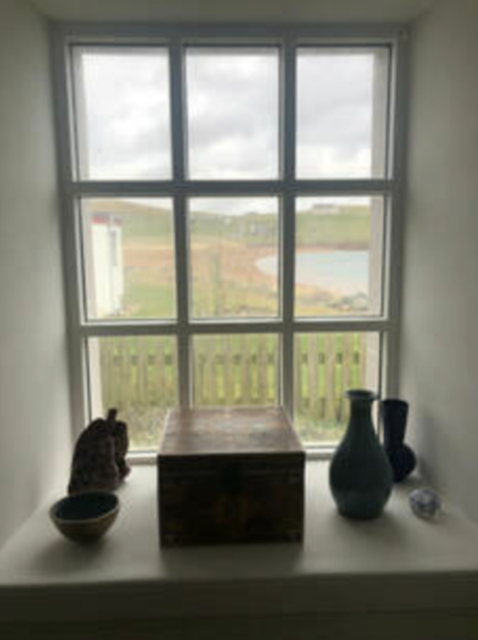The Taing, Reawick (self-catering): A review & itinerary for your stay
The Taing sits nestled on the edge of the striking red sands of Reawick beach on Shetland's west mainland, offering the ideal rural retreat
You know when someone envelops you in a warm embrace, and you feel every ounce of stress flow from your body? That’s exactly what the Taing in Reawick does. Situated just a stone’s throw from the beach, in a quiet corner of Shetland’s west mainland, the house has been lovingly restored, the interior carefully curated with every object thoughtfully placed by owners Shelagh and Peter.
The Taing, Reawick (self-catering)
Half an hour drive from Lerwick and situated on Shetland’s scenic west mainland The Taing offers everything – and more – a guest could possibly wish for. From its eclectic mix of earthenware bowls, plates and mugs, to the carefully selected artworks from locals such as Gilly Bridle and Howard Towll. The attention to detail here is to be marvelled at; from the Farrow & Ball painted door upon arrival, to the luxurious roll-top bath overlooking the beach in the ground floor bathroom. White Company candles, a complimentary bottle of merlot and crisp, white sheets on the beautifully presented beds all made for the most welcome of first impressions to this stunning beach-side property.
For me, it was love at first sight, as I’m sure it was for owners Shelagh and Peter who say that, “After many years of visiting Shetland, Peter bought The Taing with the intention of living there.
“As is often the case when buying a property, it needed more TLC than anticipated.
“Five years later, after knocking down walls, installing new heating, making it water-tight, replacing the kitchen and decorating etc. it is finally ready to be lived in and enjoyed.”
All they ask of their guests is that, “you enjoy it as much as we do.”
The Taing opened its doors to guests for the first time this year, and you can really feel the heart and soul of Peter and Shelagh in this house, which feels far more like a home than a holiday let.
The house itself is divided across two floors; with a spacious dining room, kitchen, master bedroom, bathroom and sun-porch on the ground floor, and on the second floor there’s another double bedroom, a spacious lounge with wood burning stove and second toilet with shower. In the lounge, there is a sofa bed and plenty of space to sleep more guests, and each window in the property features a commanding view, and with the exception of the kitchen, these are all out to sea across the sweeping beach.
Day One
We arrived at The Taing arout midday, and making ourselves at home, we had lunch in the bright and airy kitchen which is stocked with everything you could ever wish for, and many more eye-catching and beautifully hand-crafted pieces.
Everything in this kitchen has been carefully selected for both style and purpose, and there are art pieces everywhere you look.
After lunch – and bearing in mind we were travelling with a two and six-year-old – we went to the beach, where we scoured the tideline for shells and sea glass. Hansi set to work building some sort of dam and water diversion scheme which involved a great deal of engineering prowess (and digging). We found a little brittlestar washed up on the tide-line, which we kept in a bucket for a while before setting it free again. We had a pocket book called The Seashore but could still not identify the little five-legged creature that sprickled in our hands. But that didn’t matter; we’ll call it a brittlestar.
Searching the shoreline to find out who lives there, and why
Every beach trip needs a pocket companion!
It was no hardship to while away an hour at the beach. The sand is incredible, with distinct bands of colour and texture, alternating between sand, gravel and shingle, interspersed with chunks of volcanic rock deposited intermittently across this striking sand. This area of the west mainland is geologically diverse – as is Shetland as a whole – Reawick and the surrounding area sit on a bedrock of red granite which gives rise to this wonderfully rich, burnt orange sand. It’s incredible the wonders that can lie beneath your feet in Shetland, and that’s why we were awarded Geopark status in 2009.
Things to do in the area:
There's plenty to do in the area, particularly for those who have a love of solitude, walking and fantastic landscapes. For the keen hiker, this is the perfect base to explore some of the hidden gems of the west mainland, of which there are plenty. We stayed at The Taing for two days and I have highlighted our walks below.
A note on walking: Here in Shetland you are free to explore and roam. Just remember to leave gates as you find them, and stay safe. For more information, check this post about the Outdoor Access Code in Shetland.
Coastal circular walk from Reawick beach – Roeness – beach
Walk distance: 4 miles
Time taken: 3 hours (with much stopping and picnicking along the way)
Once we peeled the bairns away from the sand, we headed off up the hill to explore the surrounding coastal routes around The Taing. Despite a few protestations from little legs, and many pit stops to pat ponies, enjoy picnics, examine animal skulls and poops and rabbit hole scree’s, we completed the four-mile walk south from The Taing to Roeness and back. We made this walk into a loop, rejoining the track, and then the road, at the Roeness house. An idyllic walk which took in stunning coastal scenery; sea caves, a natural arch, cliffs teeming with the cackles of fulmars and the alluringly named ‘Johnny Sinclair’s Nose’. What was this feature, which stood out on the OS map like a shark in a fish tank?
Who was Johnny Sinclair and why is his nose on the map? A quick check at Canmore (the national record for the historic environment) reveals that it is: “A 3m wide and 0.5m high earthen bank running perpendicular to the coast. It is eroding over very high cliffs at its S extremity. It lies in rough grazing and is visible for over 50m inland.”
I can’t say that this feature in the landscape stood out as much in reality as it did on the map, but we did discover his nose, and marvel at the land-use of past societies farming at Roeness.
But the truth is, nose or not, this walk is worth doing for the coastal scenery alone; for the wild bubble and cackle of the fulmar’s colonies, the dramatic cliffs and the rugged coastline.
Looking out to sea we enjoyed stunning vistas to Hamnavoe to the east, Fitful to the south and Sandsound to the north. This is an area that I hear about every summer as dad makes his annual pilgrimage to the Haddock Sands in search of – yes, you guessed it – haddock.
Arriving back at The Taing at tea time, and with the evening sun shining in on the valley, lighting up the faces of the daffodils that lined the roadsides and verges, I couldn’t resist the pull of the ocean. The low light creating shimmering prisms on the turquoise sea was too tempting. So despite the cool April temperatures, I put on my wetsuit and splatched into the sea.
Curry for tea, and a quick cycle, which was cut short when I realised that actually my legs were pretty done in after all the walking. (Not from the snorkelling as I really just floated like a selkie until the cold water seeped into my hood and gave me brain freeze).
And back at The Taing at night, the fire warmed our weary toes. It was a real pleasure to sit with a glass of red wine, feeling rosy cheeks throb after a welcome dose of early spring sunshine. It’s easy to get caught out after the winter, and we forget how the sun can catch you unaware on a bright, breezy April afternoon – I’m sure we could have all done with a little after-sun (believe it or not).
As the sun set, we listened to the gentle hush as the waves washed up the beach. A soothing melody as I lay in bed beside two weary bairns on the cusp of sleep; sitting on the edge of a dream. It’s in moments of calm reflection like these that I’m able to really count my blessings, and appreciate the wonders of where we live.
Day Two
We woke to the call of the shalders (oystercatchers) on the beach, and the waves washing over the sand – the smell of fresh coffee wafting through the house from the kitchen. Or at least that’s what would have happened had we been without children. In reality, we woke with two small humans invading our peaceful slumber, and we argued over who was going to make the coffee. But, with coffee in hand and peace restored, we could lay in bed gazing out the window and plan the day ahead. The wind had freshened overnight, and I could hear it forcing its way down the lum like thunder.
We had a slow and easy morning, soaking up the morning light that flooded into the east-facing Taing. It was hard to peel ourselves away from the house. It has such a calming effect; it pulls you into its warm embrace forcing you to surrender to its four walls. Steeped in memories and history, I always find myself daydreaming and thinking about the people who lived here, and the lives they led. Old houses do that to me. (Our house does too, and I spoke about that here).
Two cups of coffee later, and after admiring the array of beautiful pottery that seemed to fill every cupboard and corner, we were ready to hit the road again. After breakfast, we headed out and decided to do the Culswick Broch walk, which you can find full details of here.
Culswick Broch walk:
Walk distance: 3 miles (4.6km)
Time taken: 3 hours
The walk is a total of 3 miles (4.6 km) and we did it by bike, but probably only at a walking pace (bearing in mind we had a two and six-year-old in tow). It’s an excellent walk and I would allow an hour each way with an additional hour for exploring the ruined houses of Sotersta, as well as the broch and spectacular coastline along the way – so to enjoy it, allow three hours from start to finish.
A few miles from Skeld, Culswick is a dramatic, lush valley, forking into two with a bog in the centre, separating the east and west side – at the head of the valley, a storm beach now blocks the sea from entering the sheltered confines, or basin, into what would have been a sea loch (or flooded landscape).
Houses are scattered on either side; childhood haunts with familiar and friendly faces. I spent many a happy day in Culswick, and it brings back tremendous memories whenever I have the pleasure of visiting. As bairns, we were always warned away from its boggy soft-centre. Confined to the slopes, we had fun nonetheless and spent many a summer evening camping. Tucked in under the hills, cocooned in a womb of endless summer, the world beyond us was forgotten.
Mother will kill me for this but, – on the night that Nostradamus proclaimed the world would end, I remember vividly, Magnie brought out his gramophone to play, while mam was tearfully mourning the end of the world in our tent, unable to sleep for fear that it was her – and our – last night on earth. Sweeping my two sisters and me tight into her chest, I remember trying to console her, explaining that science had evolved (and so should she!). Thankfully the predictions of Nostradamus (and mother) never materialised, and the sun rose again.
A sweet microclimate, some of Shetland’s best gardens flourish here under the glacially sculpted slopes which shelter it from the worst of the weather – and the world beyond.
For the walk, we parked beside the iconic red British phone box which sits in the middle-of-nowhere. We made our way up the hill to where the small Culswick Chapel sits, this tiny methodist kirk still has services (although not weekly), and the annual carol evening is a firm favourite for people throughout Shetland who want to soak up the atmosphere of this tiny place of worship.
The walk, or cycle (we used mountain bikes, and I wouldn’t recommend anything other as the road is rutted and uneven), is moderately easy and passes through moorland, skirting the Loch of Sotersta before winding its way up the hill where the Broch and the Loch of Brough come into full view. It’s worth taking a little detour down to the abandoned township of Sotersta where the houses now stand roofless and soak up the atmosphere of this once thriving community.
Despite the track taking you across the moor, the landscape doesn't disappoint. Dramatic and rugged; I always try to imagine how the people of this unforgiving and exposed corner of the west mainland eked out a meagre living in this windswept plateau.
Plantiecrubs – small stone structures for growing young cabbage (kale) plants – still stand; a nod towards a crofting past here, a time of industry, hard work and bondage to the land.
Today, look out for the moorland birds, the laverock (skylark); lapwing and shalder (oystercatcher) are all abundant here. And look out for the whaap (curlew); endangered around the UK but thriving here in Shetland. As you get closer to the coast, try to spot the fulmars, shags and other seabirds.
At the end of the track, we abandoned bikes and made the final ascent on foot. Passing over a stone causeway that slices through the Loch of Brough, the last leg does not disappoint. The spectacular views that greet you at the top ensure that the final effort is totally worth the throbbing knee-burn to get you there. Take a breath halfway up the climb, and admire the ruins of the house tucked into the lee, nestled in the shadow of the past. The house was built from stone taken from the broch that overlooks it – and now also sits in ruin – representing another strand of the rich history here.
The broch, like many others, has collapsed and been robbed of most of its stone, although the walls can be clearly seen and still stand several metres high in places. The impressive ramparts, internal chambers and a massive triangular lintel stone above the doorway are also still visible, and on a day of chill easterly wind, the remaining interior was a welcome break from the elements to enjoy a quiet picnic.
‘What is a broch?’ I hear you cry! A broch, in simple terms, is a round stone structure which is constructed using two drystone walls – an inner and outer – with a staircase built between the two to reach the top. They date to about 2,000 years ago – the mid-Iron Age, and they are unique to the north and west of Scotland. We have about 120 of them here in Shetland – most lie in ruin (and Mousa is the best example in the world – you can read about that here). Archaeologists still dispute what they were used for – whether they were defensive or offensive; or were they storehouses, or high status ‘manor houses’ of local chieftains? We don’t know. All that we can be sure of is that they are shrouded in mystery, and carry so much intrigue about past societies and how people lived and worked here in Shetland.
These are illustrations of the Mousa Broch, but they give a good understanding of broch construction
After the cycle, we were all pretty done in so we had a leisurely afternoon taking in the play parks of Skeld and Waas (Walls), with a pit-stop at the Waas shop for a Muckle Puckle loaf from the bakery and some ice creams for the bairns.
When we got back to The Taing Aaron headed indoors to prepare dinner (result!), and I went to the beach with the bairns. A glass of wine in hand, and sheltering under the bank at the burn, we whiled away an hour as the bairns dug holes and looked for shells and I listened to the sounds of the sea and sky – it was a magical hour (which I wrote a poem about, but am not yet brave enough to publish!).
Another night of inactivity with cheeks burning and legs aching. What a feeling to be beside the fire warming and listening to the rhythmic sound of the sea crashing on the beach, it’s incredibly soothing, and certainly good for the soul.
I felt very connected to the landscape while we were staying at The Taing. Being so close to the sea, I was aware of the rise and fall of both tide and wind. I watched as the shalders (oystercatchers) assembled on the tide line after the dog-walkers had left, and how the fulmars settled down as the sun dipped. The shag, in low flight, made a steady ascent across the bay to bed down too. It was magical. This is the home of the bird. The fulmars conquer the cliffs in a heady display of flight – of graceful elegance as they soar into the wind. Meanwhile, the shalders command the shoreline, fleeting back and forth with the approach and retreat of every wave. And from above, the laverock (skylark) rules the moors, while the blackbirds congregate in a merry babble of noise from surrounding outbuildings and telegraph poles.
Bedtime, often an ordeal at home, was a pleasure at The Taing. As the bairns were tucked into the sumptuous bed, nestled in a flurry of white cotton, I read to them. We read My Naughty Little Sister because Lena is the very epitome of the character in Dorothy Edwards’ iconic children’s classic. And then we read How to Train Your Dragon, because Hansi is six, and when you are six, dragons are life.
As they fell into a deep, fresh-air induced coma, I watched out the sash windows as the water tickled at the edges of the red granite beach and a lone gull plucked at the tang on the tideline. It’s easy to understand why this house was built on this sleepy beach at the foot of the lush green valley of Reawick.
Our time at The Taing was too short; I would happily base myself here for a week, or longer if time would allow. It’s the perfect place to escape to – and yet only half an hour from town. I certainly wouldn’t tire of the coastal walks, the archaeology, the scenery, the sounds and all the hidden corners we discovered along the way. I imagine The Taing would be as good in the depths of winter as it would be in the height of summer, and as every hour brings a change here; in the light as the sun traces around the gable of the house, in the sounds as the cacophony of birds fill the sky from first light till last. And of course, the ever-present sea, with the constant ebb and flow of the tide.
It is hard not to feel inspired being here. If I were an artist, I’d be sat in the bright sun porch fronting onto the beach with my watercolours poised. But for the writer in me, there were no shortages of corners, chairs and sun-dappled windows to sit in with a glass in hand, each space a carefully curated masterpiece.
Well done to Shelagh and Peter for creating such an inspiring space, and thank you for letting us stay.
Note:
There is so much to do in and around Reawick and I would highly recommend Peter Guy’s book: Walking the Coastline of Shetland: Westside (No 5), which you can buy here.
Another great walk, a few miles from Reawick, is to the Stanydale Temple, a Neolithic site which you can read about thathere and here.
Westerwick is also a great walk, especially between Silwick and Westerwick. The views are unforgettable. Westerwick is only a few miles from Reawick.
Sand Gairdins is a great place to visit if you have young children.
Hopefully this review and itinerary are helpful in allowing you to begin your Shetland adventure here.
To contact Shelagh and Peter about booking you can visit their websitehere, or follow them on Instagramhere.
If you are interested in a tour while visiting just drop me an email for more information.
With love,



































